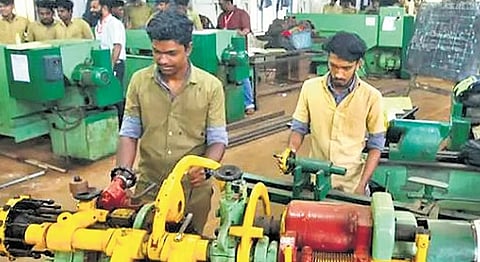

TIRUCHY: Even as the district got two new government industrial training institutes, offering a combined 250 seats, in August, dropout rates hovering at 30%, “weak” industry tie-ups and “low” entry-level wages offered to students who secure placements during the course continue to challenge the ITI ecosystem.
This year, ITI-Thiruverumbur, the oldest and largest in the district, admitted around 700 students of the sanctioned intake of 844.
The institute at Pullambadi filled 265 of 315 seats, and Manikandam 210 of the total 228 seats. With the newly added ITIs at Manachanallur and Manapparai admitting around 200 students combined, the district now has around 1,400 enrolled against the total capacity of around 1,600.
M Elangovan, principal of ITI-Thiruverumbur, said the improved industrial climate has translated into better job opportunities.
"With industrial units around Tiruchy getting steady orders from BHEL and SAIL, placements have become easier.” Many students, however, stop upskilling once they land their first job, he said.
"Another concern is the low salary offered by local industries. We have now fixed Rs 15,000 as the minimum monthly pay for companies recruiting through campus placement," he added.
Around 80% of the students in the ITIs secure campus placement, sources said. Meanwhile, a faculty member at one of the ITIs noted that the average dropout rate remained high – around 30%, according to officials - despite regular counselling.
"Most of our students are school dropouts. We divert them into skill training, but distractions are common and some leave mid-way despite our efforts," the faculty member said. "Our focus now is on reducing dropouts, expanding apprenticeship opportunities and aligning training more closely with industry needs," said a senior official from the district skill development office.
Pointing out the importance of apprenticeships, Assistant District Skill Development and Training Officer M Muthazhagi said, "Public-sector units like NLC, BHEL and SETC give students valuable specialised training. Many, however, are drawn to temporary jobs offering slightly higher pay, which affects long-term growth. Retaining them is difficult, especially since many are already school dropouts."
Echoing Muthazhagi’s views, A Kuppuraj, former principal of ITI-Thiruverumbur, said, "Although the government conducts job melas to promote apprenticeships, only about 30 to 50 per cent of students take them up. Many prefer to join industries immediately. Stronger industry-institute partnerships are vital - companies must come forward to offer training that matches their skill requirements."
Meanwhile, S Ashok Sundaresan, former president of the BHEL Small and Medium Industries Association (BHELSIA), said the demand for skilled workers, particularly in welding and fitting, remains high. "Most MSMEs hire through contractors, which keeps wages low. Larger units that recruit directly pay at least Rs 600 a day, but they expect candidates with apprenticeship or at least two years of specialised training," he noted.
The story is reported by Vivanesh Parthiban for The New Indian Express
